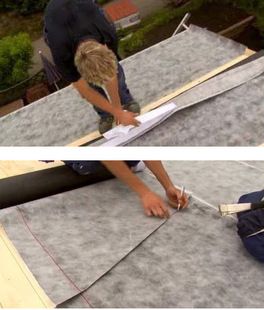Building houses will be deformed under the influence of climate and external pressure. In order to prevent cracking or deformation of the walls, deformation joints will be reserved on the roof. These deformation joints will continue to change with external factors such as temperature, humidity, and reasonable settlement of buildings. Therefore, construction workers need to perform multi-layer waterproof treatment on the deformation joints to avoid changes in the width of the deformation joints and damage the waterproof layer.

Roof deformation joint types
Deformation joints can be classified into expansion joints, settlement joints and shockproof joints according to different functions. Expansion joints mostly refer to cracks that cause expansion and deformation of the floor in order to avoid weather and environmental factors such as temperature and humidity. Such gaps are mostly vertical climb deformation joints, which are raised or flush with the roof and have double gutter gaps. As the name implies, shock-proof joints are designed to avoid structural deformation joints set by earthquake disasters, so that the structure of the building is not easily destroyed. Settlement joints are used for building structural joints in several different sections when there is a large gap between the height of the same building and the gravity of the upper load. This kind of gap is also common at the junction of old and new buildings.
Waterproofing of roof deformation joints
Regardless of the type of waterproof material and waterproof structure used for roof deformation joints, multiple defenses are required, and when the width of deformation joints is changed, the waterproof structure will not be damaged.
Waterproofing of expansion joints is generally done by applying a waterproof layer and a gap joining material at the bottom of the waterproof wall, and then applying a cloth and two reinforcing layers on the surface.
Settlement joints are mostly high and low deformation structures. Usually, the waterproof treatment is to set the membrane as a waterproof layer on the roof, and the coiled material is pressed against the high-rise wall so that it is recessed in the gap and fixed on the top of the high-rise wall while sticking. On the waterproof layer of the roof, the surface of the coil is further protected with a metal plate. Then, the construction staff performs the waterproof layer coating process and bonds the synthetic polymer web with the waterproof layer coating film.
The waterproof layer of the shockproof joint should be higher than the top wall of the roof or the top surface of the side wall of the gutter. The upper part of the wall should be covered with a synthetic polymer coil, and it should be recessed in the middle of the coil to about 2cm inside the deformation joint. Polyurethane foam strip, connecting the two sides of the wall with the waterproof layer of the roof, and then a layer of synthetic polymer membrane is added. The two sides of the membrane cover the connection seam of the upper layer of the coil material. Finally, the fine stone concrete or stainless steel is used. The lid is covered so that the overall waterproofing is completed.
In short, the waterproof layer of the deformation joint of the roof shall be attached to the upper part of the masonry on both sides of the deformation joint, and its height shall not be less than 25 centimeters. In order to ensure the effect of waterproofing, it is forbidden to use unqualified paint for waterproofing the deformation joints of the roof. Before the construction, the paint must be inspected, and pay attention to the storage method and the service life of the paint.